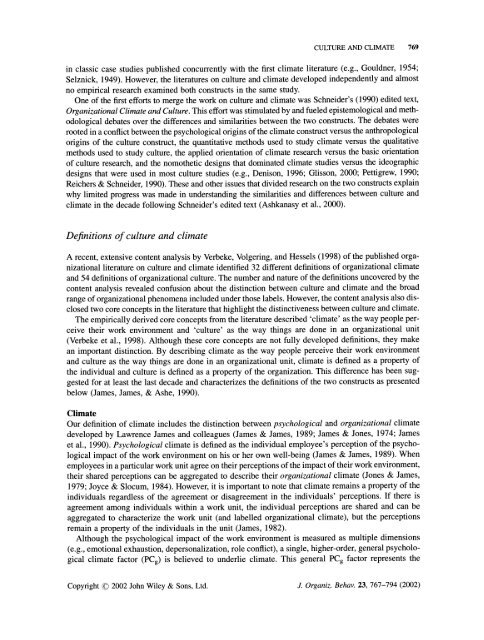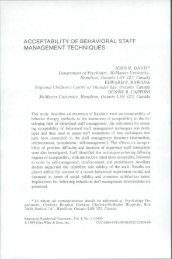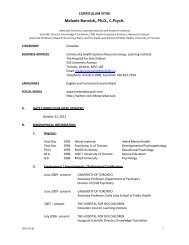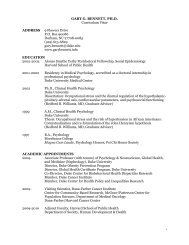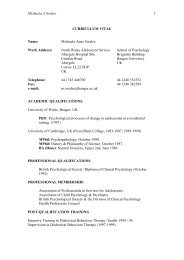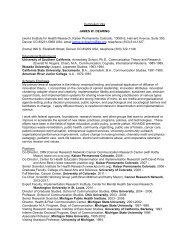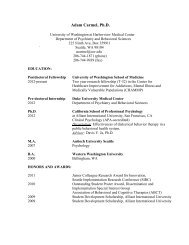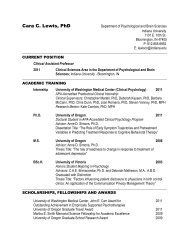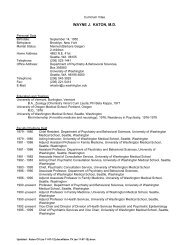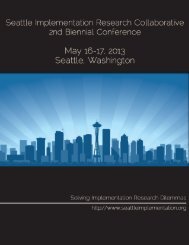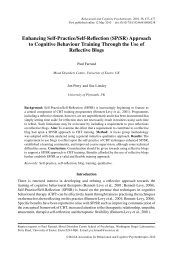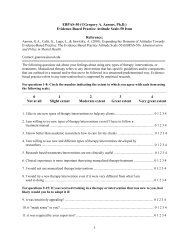The Cross-Level Effects of Culture and Climate in Human Service ...
The Cross-Level Effects of Culture and Climate in Human Service ...
The Cross-Level Effects of Culture and Climate in Human Service ...
Create successful ePaper yourself
Turn your PDF publications into a flip-book with our unique Google optimized e-Paper software.
CULTURE AND CLIMATE 769<br />
<strong>in</strong> classic case studies published concurrently with the first climate literature (e.g., Gouldner, 1954;<br />
Selznick, 1949). However, the literatures on culture <strong>and</strong> climate developed <strong>in</strong>dependently <strong>and</strong> almost<br />
no empirical research exam<strong>in</strong>ed both constructs <strong>in</strong> the same study.<br />
One <strong>of</strong> the first efforts to merge the work on culture <strong>and</strong> climate was Schneider's (1990) edited text,<br />
Organizational <strong>Climate</strong> <strong>and</strong> <strong>Culture</strong>. This effort was stimulated by <strong>and</strong> fueled epistemological <strong>and</strong> methodological<br />
debates over the differences <strong>and</strong> similarities between the two constructs. <strong>The</strong> debates were<br />
rooted <strong>in</strong> a conflict between the psychological orig<strong>in</strong>s <strong>of</strong> the climate construct versus the anthropological<br />
orig<strong>in</strong>s <strong>of</strong> the culture construct, the quantitative methods used to study climate versus the qualitative<br />
methods used to study culture, the applied orientation <strong>of</strong> climate research versus the basic orientation<br />
<strong>of</strong> culture research, <strong>and</strong> the nomothetic designs that dom<strong>in</strong>ated climate studies versus the ideographic<br />
designs that were used <strong>in</strong> most culture studies (e.g., Denison, 1996; Glisson, 2000; Pettigrew, 1990;<br />
Reichers & Schneider, 1990). <strong>The</strong>se <strong>and</strong> other issues that divided research on the two constructs expla<strong>in</strong><br />
why limited progress was made <strong>in</strong> underst<strong>and</strong><strong>in</strong>g the similarities <strong>and</strong> differences between culture <strong>and</strong><br />
climate <strong>in</strong> the decade follow<strong>in</strong>g Schneider's edited text (Ashkanasy et al., 2000).<br />
Def<strong>in</strong>itions <strong>of</strong> culture <strong>and</strong> climate<br />
A recent, extensive content analysis by Verbeke, Volger<strong>in</strong>g, <strong>and</strong> Hessels (1998) <strong>of</strong> the published organizational<br />
literature on culture <strong>and</strong> climate identified 32 different def<strong>in</strong>itions <strong>of</strong> organizational climate<br />
<strong>and</strong> 54 def<strong>in</strong>itions <strong>of</strong> organizational culture. <strong>The</strong> number <strong>and</strong> nature <strong>of</strong> the def<strong>in</strong>itions uncovered by the<br />
content analysis revealed confusion about the dist<strong>in</strong>ction between culture <strong>and</strong> climate <strong>and</strong> the broad<br />
range <strong>of</strong> organizational phenomena <strong>in</strong>cluded under those labels. However, the content analysis also disclosed<br />
two core concepts <strong>in</strong> the literature that highlight the dist<strong>in</strong>ctiveness between culture <strong>and</strong> climate.<br />
<strong>The</strong> empirically derived core concepts from the literature described 'climate' as the way people perceive<br />
their work environment <strong>and</strong> 'culture' as the way th<strong>in</strong>gs are done <strong>in</strong> an organizational unit<br />
(Verbeke et al., 1998). Although these core concepts are not fully developed def<strong>in</strong>itions, they make<br />
an important dist<strong>in</strong>ction. By describ<strong>in</strong>g climate as the way people perceive their work environment<br />
<strong>and</strong> culture as the way th<strong>in</strong>gs are done <strong>in</strong> an organizational unit, climate is def<strong>in</strong>ed as a property <strong>of</strong><br />
the <strong>in</strong>dividual <strong>and</strong> culture is def<strong>in</strong>ed as a property <strong>of</strong> the organization. This difference has been suggested<br />
for at least the last decade <strong>and</strong> characterizes the def<strong>in</strong>itions <strong>of</strong> the two constructs as presented<br />
below (James, James, & Ashe, 1990).<br />
<strong>Climate</strong><br />
Our def<strong>in</strong>ition <strong>of</strong> climate <strong>in</strong>cludes the dist<strong>in</strong>ction between psychological <strong>and</strong> organizational climate<br />
developed by Lawrence James <strong>and</strong> colleagues (James& James, 1989; James & Jones, 1974; James<br />
et al., 1990). Psychological climate is def<strong>in</strong>ed as the <strong>in</strong>dividual employee's perception <strong>of</strong> the psychological<br />
impact <strong>of</strong> the work environment on his or her own well-be<strong>in</strong>g (James& James, 1989). When<br />
employees <strong>in</strong> a particular work unit agree on their perceptions <strong>of</strong> the impact <strong>of</strong> their work environment,<br />
their shared perceptions can be aggregated to describe their organizational climate (Jones & James,<br />
1979; Joyce & Slocum, 1984). However, it is important to note that climate rema<strong>in</strong>s a property <strong>of</strong> the<br />
<strong>in</strong>dividuals regardless <strong>of</strong> the agreement or disagreement <strong>in</strong> the <strong>in</strong>dividuals' perceptions. If there is<br />
agreement among <strong>in</strong>dividuals with<strong>in</strong> a work unit, the <strong>in</strong>dividual perceptions are shared <strong>and</strong> can be<br />
aggregated to characterize the work unit (<strong>and</strong> labelled organizational climate), but the perceptions<br />
rema<strong>in</strong> a property <strong>of</strong> the <strong>in</strong>dividuals <strong>in</strong> the unit (James, 1982).<br />
Although the psychological impact <strong>of</strong> the work environment is measured as multiple dimensions<br />
(e.g., emotional exhaustion, depersonalization, role conflict), a s<strong>in</strong>gle, higher-order, general psychological<br />
climate factor (PCg) is believed to underlie climate. This general PC, factor represents the<br />
Copyright ) 2002 John Wiley & Sons, Ltd.<br />
J. Organiz. Behav. 23, 767-794 (2002)


